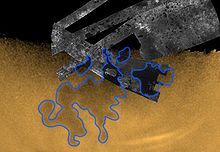Kraken Mare
synthetic aperture radar images showing all of Kraken Mare. The large island Mayda Insula is left of top center, and Jingpo Lacus is at upper left. A portion of Ligeia Mare enters the view at top right. | |
| Feature type | Mare |
|---|---|
| Coordinates | 68°N 310°W / 68°N 310°W |
| Diameter | 1,170 km[note 1] |
| Eponym | Kraken |
Kraken Mare
Description
At 500,000 km2,
An island in the sea is named
The narrow constriction in the sea at 317°W, 67°N, about 17 kilometres (11 mi) wide and similar in size to the Strait of Gibraltar, officially named Seldon Fretum,[8] has been termed the 'Throat of Kraken' and suggested to be a location of significant currents.[9] Titan's orbital eccentricity may lead to tides of 1 metre (3.3 ft) in Kraken Mare, generating currents here of 0.5 metres per second (1.6 ft/s; 1.1 mph; 1.8 km/h) and possibly whirlpools.[6] Other calculations estimate tides as high as 5 metres (16 ft).[2]
Changing features known as "Magic Islands" are observed in Kraken Mare. These features, which are further indications of an active hydrocarbon cycle on Titan, are possibly rising bubbles due to nitrogen
Observation and exploration
Kraken Mare, along with other Lakes of Titan, was first discovered by the Cassini–Huygens space probe on July 22, 2006. This was accomplished by noticing that certain dark regions, especially near the poles, had low radar reflectivity, as well as similar morphological features to that of terrestrial lakes.[12] Many observations since have confirmed these findings.[13][2][14] In addition to the radar images, the Cassini instrument VIMS (Visible and Infrared Mapping Spectrometer) has surveyed Kraken Mare and its surroundings.[13]
There have been multiple proposals and ideas to explore the depths of Kraken Mare via probes and submarines. One such submarine has gone through a phase one NASA study, complete with submarine design and schematics.[15] Another proposal, the Titan Mare Explorer was a finalist to explore another lake Ligeia Mare, with Kraken Mare as a secondary target, but InSight, a Mars lander, was ultimately approved instead.[16] The Titan Mare Explorer was also suggested for inclusion on the unprogressed Titan Saturn System Mission.
While a mission to Titan has been approved, the drone Dragonfly, there are no current missions to explore Kraken Mare or other lakes on Titan.[17]
Gallery
-
Synthetic aperture radar image (top) overlaid onto a visible light/infrared image of Titan's north polar region, showing the full extent of Kraken Mare.
-
Radar image showing the northern portion of Kraken Mare, including the large island Mayda Insula.
-
Radar image of a portion of Kraken Mare with a rugged coastline and numerous islands.
-
Specular reflection off Jingpo Lacus in the Kraken Mare region, observed by Cassini on July 8, 2009.
See also
Notes
- ^ The USGS web site gives the size as a "diameter", but it is actually the length in the longest dimension.
References
- ^ USGS Astrogeology Science Center. Archivedfrom the original on August 8, 2018. Retrieved March 16, 2012.
- ^ from the original on January 20, 2021. Retrieved September 14, 2020.
- ^ "Kraken Mare: The Largest Methane Sea Known To Humankind". WorldAtlas. April 25, 2017. Retrieved October 13, 2023.
- ^ .
- ^ Hand, Eric (December 16, 2014). "Spacecraft spots probable waves on Titan's seas". Science. Archived from the original on January 4, 2015. Retrieved January 14, 2015.
- ^ a b Lorenz, R. D. (2014). The Throat of Kraken : Tidal Dissipation and Mixing Timescales in Titan's Largest Sea (PDF). 45th Lunar and Planetary Science Conference (2014). The Woodlands, Texas. p. 1476. Archived (PDF) from the original on March 4, 2016. Retrieved June 9, 2014.
- from the original on January 25, 2022. Retrieved April 1, 2021.
- USGS. Archivedfrom the original on April 27, 2015. Retrieved May 23, 2015.
- ^ Rincon, P. (March 18, 2014). "'Waves' detected on Titan moon's lakes". BBC web site. BBC. Archived from the original on May 31, 2014. Retrieved June 9, 2014.
- from the original on August 3, 2020. Retrieved April 1, 2021.
- from the original on March 10, 2021. Retrieved April 1, 2021.
- from the original on March 9, 2021. Retrieved April 1, 2021.
- ^ ISSN 1944-8007.
- ISSN 1944-8007.
- from the original on May 29, 2017. Retrieved April 1, 2021.
- from the original on January 21, 2022. Retrieved April 1, 2021.
- ^ "NASA selects Titan drone for next New Frontiers mission". SpaceNews. June 28, 2019. Archived from the original on January 25, 2022. Retrieved April 1, 2021.





